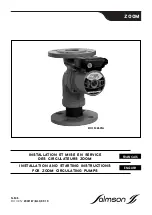
AF (6-36) IOM
35
Most axial flow pumps are in evaporator circulation
service and since the evaporator performance and the
amount of product depends on the rate of liquid
circulation, care should be taken to maintain these
pumps in good operating condition.
When production drops off, it is usually due to lower
circulation rate. An approximation of this rate can be
made by several methods:
•
Temperature drop across the heat exchanger.
•
Visual inspection of flow in evaporator body.
•
Testing the circulating pump.
Items (1) and (2) above are covered by the evaporator
manufacturer.
While field conditions preclude absolute accuracy, a
check of pump performance will give reasonably close
results. This can be done by installing a mercury
manometer at pipe taps located at least-one pipe
diameter away from the suction and discharge flanges
of the pump. If-gauges are used, the pressure
differential times 2.31 divided by the specific gravity of
the slurry indicates the TDH against which the pump is
actually operating. If a manometer is used, then
inches of mercury times 1.0455 divided by specific
gravity equals TDH, providing water is in both legs of
the manometer and connecting lines.
Check the pump speed and determine flow rate (gpm)
from the pump curve. This curve will also give
efficiency from which the hp requirement can be
determined. A double check is to take motor ammeter
readings, convert to hp, figure 90% drive efficiency,
and use it against the pump curve to get GPM. This is
only an approximate check, as the hp curve on some
applications is rather flat, but is probably within 7-
1/2%. It is important to take and record these readings
when the equipment is new, so that later readings can
be judged on a relative basis.
OPERATING AT REDUCED CAPACITY
WARNING
DO NOT operate pump below minimum rated flows
or with a discharge valve closed. This condition
may create an explosive hazard due to
vaporization of pumpage and can quickly lead to
pump failure and physical injury.
Driver may overload if the pumpage
specific gravity (density) is greater
than originally assumed, or the rated
flow rate is exceeded.
Listed below are some causes for circulation loss.
Keep in mind that operation at reduced capacities can
cause damage to the pump.
1. Increase in TDH against which pump operates
could be caused by:
a) Heat exchanger tubes partially plugged.
b) Too many heat exchanger tubes blanked off.
c) Improperly sized or partially plugged strainer.
2. Viscosity of slurry higher than it should be.
3. Pump speed low. V-belt drive may be slipping and
operating pump below design speed.
4. Pump throttled on suction side. Could be caused
by rubber lining pulling away from the suction pipe
and partially collapsing, by large solids dropping
into suction, or by improperly sized or-plugged
strainer in the suction pipe.
5. Pump partially plugged by large solid jammed
between two impeller blades. This will also cause
rough operation with excessive vibration.
6. Incorrect pump rotation. When changing motors
for any reason or after any electrical system
changes or modifications, always check motors for
correct direction of rotation.
7. Worn pump impeller and/or casing. On a new
pump, clearance between tip of impeller blade and
casing is carefully determined. As this clearance
increases, pump performance decreases.
It is not practical to predict performance at any given
clearance without running a test at this clearance. On
small pumps, this effect is magnified as the
percentage of impeller blade area lost from wear and
corrosion is higher.
Other pump conditions and possible causes are:
High Hp Demand
1. Increased head or viscosity
2. Pump speed too high
3. Specific-gravity of slurry higher-than normal
4. Packing gland pulled up too tight
5. Impeller rubbing in casing
4
!
Summary of Contents for Goulds Pumps AF
Page 1: ...Installation Operation and Maintenance Instructions Model AF 6 36 MXR Bearings ...
Page 3: ...AF 6 36 IOM 6 THIS PAGE INTENTIONALLY LEFT BLANK ...
Page 5: ...AF 6 36 IOM 8 THIS PAGE INTENTIONALLY LEFT BLANK ...
Page 14: ...10 AF 6 36 IOM THIS PAGE INTENTIONALLY LEFT BLANK ...
Page 32: ...28 AF 6 36 IOM ...
Page 34: ...30 AF 6 36 IOM THIS PAGE INTENTIONALLY LEFT BLANK ...
Page 48: ...44 AF 6 36 IOM THIS PAGE INTENTIONALLY LEFT BLANK ...
Page 66: ...62 AF 6 36 IOM AF SECTIONAL shown with optional restrictor bushing adapter Fig 77 ...
Page 68: ...64 AF 6 36 IOM AF OPTIONS Fig 78 351 370F 126 ...
Page 69: ...AF 6 36 IOM 65 MXR BEARING CONFIGURATIONS 1MXR 3MXR 4MXR 6MXR Fig 79 540C 6 ...
Page 72: ...68 AF 6 36 IOM THIS PAGE INTENTIONALLY LEFT BLANK ...
















































